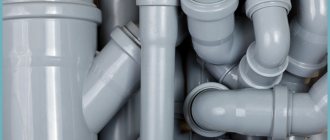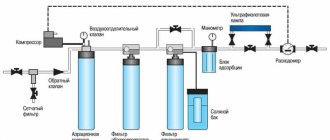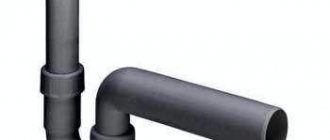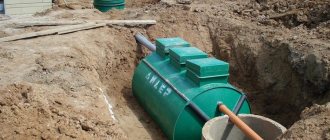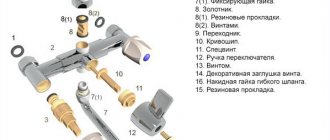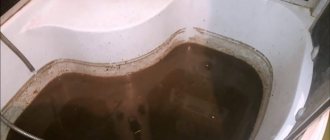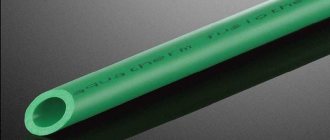A properly functioning sewer system in an apartment or house does not remind you of itself in any way; the water goes quickly and quietly into the drain, from where it is pumped into the collector. And this should be the case all the time, which is why a complex system of pipelines, sewer risers and other structures is designed. But the complex often malfunctions and gurgling begins in the sink, bathtub, toilet, and sometimes sounds are heard in the pipes, interfering with the usual established comfort. Why this happens and how to eliminate troubles - we’ll talk about this in more detail.
The role of air in the operation of the sewer system
When you flush water in an apartment building, the liquid immediately goes into a vertical riser. A properly functioning sewer system does not gurgle. A person hears only the sound of water and nothing else. Unfortunately, many people perceive extraneous noise as something normal. Weeks and even months pass before a person turns to a plumber for help. Statistics show that delay in this case leads to an increase in the cost of repair work.
Sewerage in the kitchen or toilet is arranged identically. The constant flow of air creates a pressure difference. As the wastewater discharges, it more actively rushes to the exit. If a “traffic jam” is formed at any stage, a specific sound immediately appears. As soon as “gurgling” sounds begin to be heard from the toilet or sink, you should immediately call a plumber.
sewer Starts to gurgle periodically
in devices. Configuration: drain to septic tank-bathtub-toilet-sink. If you drain the bathtub, it starts gurgling in the toilet. Or in the sink. At first I was guilty of freezing the pipes between the chambers of the septic tank (ovnoyamy in general). However, it is the same now with warming. Then he sinned for clogging the pipes with a small friend (the artist grows up, draws pictures and sets sail), but he is unconscious. What could it be? Lack of ventilation of the riser (and there is none at all, and it doesn’t always gurgle)? Explain the physics of the process
Discussion closed by moderator
was it before? how long from the start of operation?
It didn't exist before. It has been practically operated by me alone for 3-4 years. That is, I couldn’t fuck him up purely physically
fat increases quickly. Sometimes in 1-2 years (if (for example) a kitchen sink is connected to this place).
I recommend starting with preventive measures: pour caustic soda (caustic alkali) overnight, for example “Mole”, “Tyrette”. Our “Mole” is better. Better in granules.
After this prevention, the septic tank will restore the microflora for six months)))
Unfortunately yes. But fortunately the Author has the right septic tank? - concrete rings - their usual volume of 3 cubes will be well diluted with a tablespoon of caustic soda (and I don’t add any more).
wanders. don't shake)))
I’m also in favor of a septic tank, although mine is very different (yubas) and the vacuum valve is at the top point (which is not correct because it needs to be vented to the roof), but an air breakthrough usually occurs when it’s time to clean the septic tank. At the same time, the septic tank itself works normally.
Put a vacuum cleaner on a hundred square meters
the riser pipe is designed precisely for this purpose - so that during a volley discharge the vacuum does not break the hydraulic locks. if it is difficult to make a fan pipe, then a vacuum valve like this helps
It happened that we had to send a soldier into the septic tank and he cleaned out the drain with wire. It turned out that the kind dandy builders stuffed pieces of foam plastic into the pipe. At first the drainage came through the cracks and then the cracks silted up. Since my guano is drained separately - we are talking about a gray water septic tank - this thing worked for about 4 years and then it started.
clogging lack of ventilation of the riser
look into the septic tank, there is an opinion that it is already full; gurgling is, in principle, possible for one reason - water enters the septic tank, displaces the air, it has nowhere to go (standard air vents for some reason do not work), it breaks through the same drain sewer pipe back into the house .
All. There are no miracles. find out why your air is not going where it should (I had this happen when the pump pumping water into the ditch broke and the septic tank simply overflowed)
septic tank = two wells, the first for the aries, from which it overflows into a drainage well. Does the drainage system not drain water?
look into it yourself. Seriously. Maybe your drainage is all in the groundwater level with this thaw and high water.
Find out the cost of construction Photos Reviews
The main reasons for gurgling water in the sink
Lack of air in the system and blockage are the two most common causes of failure. However, you need to know that they are not the only ones. A detailed inspection will help you dot the i's. First you need to find out what type of sewer system is installed in the house.
Almost all apartment buildings have a vertical common riser installed. Air enters it through a hole located on the roof.
The second significant factor is the localization of the source of extraneous noise. For example, the toilet, bathtub, or just the kitchen “grunts.” The third feature that influences the nature of the problem that arises is the degree of branching of the pipeline. The more bends, the higher the risk of blockage.
You can remove the blockage either yourself or call a specialist.
Statistics of all repaired breakdowns indicate that there are only three most likely causes of the problem:
- In an apartment located down the riser, a blockage has formed - the characteristic sound disappears as the plug moves down the riser.
- The blockage is located in the apartment located higher up the riser - the least dangerous type of breakdown.
- The blockage is localized on the same floor as the apartment, in which the plumbing equipment makes specific sounds.
Once the plug is removed, there is a one-time spike in effluent levels. Each of the listed varieties requires an individual approach. The easiest and fastest option is for the owners of the apartment where the blockage is located to call a plumber. A specialist, using a special cable, removes the contamination.
Freezing pipes and other factors
The randomness factor cannot be foreseen or prevented. Even if all residents follow the rules for operating the system, problems still occur. The list opens with a bird that got into the ventilation shaft of the sewer system. As the volume of air entering the toilet decreases, a distinct gurgling sound is heard when flushing. Only an experienced plumber can remove the bird.
Before disassembling the pipe, place a container
The second common reason is frozen pipes.
Events develop as follows:
- An imbalance is created when the air temperature is low and the water temperature in the tubes is high;
- Frostbite on the internal surface of the system gradually increases;
- The plug forms within 4-5 days;
- It can only be removed while on the roof.
Even if you follow all the rules for operating the system, it is not always possible to avoid problems. If the results of the inspection indicate that it is possible to exclude a situational factor, for example, a traffic jam caused by neighbors, then you need to immediately check the factor of chance.
Typical errors during operation
Analyzing your own actions will help you find the answer to why water gurgles in the sink in the bathroom or kitchen. Many people think that there is no need to follow the rules for installing plumbing equipment. Plumbers do not agree with this formulation of the question. Ignoring certain recommendations disrupts the natural physical process.
One of the most common mistakes is installing an additional pipe near the toilet. It literally prevents waste from leaving quickly.
Numerous homemade modifications are the reason that ranks second. Consumers use parts that are not provided by the developers. This leads to a pressure imbalance. Over the course of several days, the drain will overflow outside the sink or toilet.
Why it may gurgle in the sink - the main reasons
Most often, the cause of gurgling sounds coming from the sink is air in the sewer pipes. An air lock occurs for the following reasons:
- Violation of sewerage installation rules. Each sewer unit must be equipped with an additional pipe that will prevent water from overflowing. Neglecting the presence of additional pipe elements risks disrupting the operation of the entire sewer system of the apartment.
- Blockage in the risers below, above or at the level of the apartment. The most dangerous situation is a blockage at the bottom. In this case, all the water drained from the upper floors will end up in an apartment with a gurgling sink.
Illumination with a flashlight will allow you to accurately determine the location of the blockage in the siphon.
Tips for eliminating gurgling noise in the kitchen
The main advice of plumbers when the first gurgling sounds appear is to immediately find out the cause. Most often, sounds in the kitchen sink are caused by a clogged siphon. First of all, it is necessary to clean this part of the drainage system. The problem is solved in one of the following ways:
- unscrew all parts of the siphon, clean and rinse them;
- pour a special pipe cleaner into the sink drain hole;
- replace the dirty siphon with a new one.
If no blockages are found in the pipes and risers, the gurgling problem will be solved by installing a special tee between the corrugated siphon pipe and the sewer outlet. An air valve is mounted in a vertical socket to increase the air vacuum. After installing the tee, the sounds will disappear and the risk of blockages will be reduced.
One of the reasons for extraneous sounds from the sewer system is a clogged air duct riser on the roof of the building. Often the culprits of this trouble are the residents themselves. Sometimes a bird can get into the pipe. It is necessary to remove the blockage from the roof. You can’t push it inside, it will only make the situation worse.
A popular cause of sewer gurgling is frozen pipes. At extremely low temperatures, the pipe walls become covered with ice, so air access to the sewer is limited. The ice plug is also broken from the roof.
Squelching and gurgling sounds in the kitchen sink are always a harbinger of an impending problem. They cannot be ignored, otherwise unpleasant consequences cannot be avoided. Before choosing a method to solve the problem, you need to study the structure of the sewer system, and it is better to seek help from specialists.
An efficient sewer system never gives cause for unnecessary concern. It is comparable to a clock mechanism; any drainage of water occurs clearly, without delays and unnecessary sounds and smells. But this doesn't always happen.
How to Eliminate Bad Odor from the Kitchen Sink
The smell of fried potatoes with onions, fresh borscht, juicy cutlets - these are the usual kitchen companions. The place where a woman prepares food should be clean and comfortable. And how surprised will you be if you smell sewage from the sink? It is absorbed into clothes and accompanies you everywhere. It's even worse if you're planning a dinner party, which, with the appearance of a nasty smell, will clearly reflect poorly on your reputation. In this article, we will tell you the main causes of odor and gurgling in the sink and help you eliminate this problem once and for all.
Causes of unpleasant odor in the kitchen.
The sink is cleaned to a shine. There are no leftover food anywhere. The dishes are clean. And the smell appears and then disappears again. What is the reason? There are many reasons and they are all different, as well as ways to eliminate the smell from pipes in the kitchen. Sink stench occurs when:
- Mistakes made during sewer installation;
- Incorrect operation of the water seal;
- The occurrence of sewer leaks;
- Insufficient ventilation in the room;
- Pipeline clogged.
Why is it important to have a basic understanding of how the sewer system works?
Any sewer network located in a house or high-rise building is a complex system that operates according to certain physical laws. This is a whole complex consisting of special devices, siphons, pipes and risers. All elements are connected into one circuit.
The structure of the sewer network may differ in some of its individual parts, because a private house itself or a multi-storey building are completely different structures. To maintain high-rise buildings, the method of discharging water through a vertical riser is often used. But for a private home, there is no need to use such an element.
It is important to understand everyday issues related to the proper functioning of the sewage system. Indeed, if various problems arise, the participation of the residents themselves in solving them may be required. There is always the opportunity to contact specialists. But sometimes the problem isn't worth it. You can solve it yourself.
Insufficient or incorrect ventilation will definitely cause gurgling sounds
Any autonomous sewer system must have ventilation, since when draining, air is needed to take the place of the drained water - and either this air will enter the riser from the ventilation, or from the drain holes of plumbing fixtures, through a broken water seal. In a private house in winter, ventilation may be disrupted, for example, because the drain pipe may freeze and become clogged with ice from the outside. Sometimes foreign objects get into the drain pipe, and even a bird can get stuck in it - so first of all, check the condition of the drain pipe!
>
Air and its role in the sewerage system
Understanding how the sewer system works is not difficult. Knowing about clear actions in emergency situations is the only destiny of residents. More often than not, most people use the sink, toilet or bathtub without even paying attention to clearly audible problems. And this happens more than one day, or even a week. The gurgling sound from the pipes is perceived as the proper state of affairs. This is precisely where the mistake lies.
A “healthy” sewer system quickly and quietly absorbs wastewater, which it discharges from the sink, bathtub or toilet into a common drain pipe. It is connected to a riser, the end of which goes into a special collector. But not everyone has an idea of what forces drive runoff. The other end of the riser has an outlet to the atmosphere. In multi-storey buildings it is located on the roof, and in private buildings it is located next to the house.
The liquid is discharged using a stream of air drawn into the pipe from the street. Due to the generated pressure, the waste quickly leaves the cavity of the drain pipe and is pushed into the collector. It is this process that is important.
If the sink gurgles, it means a plug has formed.
And it depends on his understanding whether a person can independently cope with possible malfunctions in the sewerage system. And you won’t need to bother anyone with the question: “why is water gurgling in the sink and what should I do?” The answer is clear - a traffic jam has formed. The reason may be:
- pipeline clogging;
- insufficient air in the system.
It remains only to figure out which of the two factors influenced the fact that a growling sound is heard from the sink.
Causes of gurgling sounds and their elimination in a private home
As a rule, people pay little attention to quiet sounds when rushing to work or on errands. But when the “symphony” only increases its sound speed and lasts for weeks, months, the situation can get out of control and flood not only the floors in the kitchen, but throughout the whole house. The reason can only be determined by learning how the spillway system functions.
The pipeline includes many separate sections of pipes and pipes, assembled into a single riser, which removes wastewater. In particular, when water is discharged into the toilet, the flow rushes into the collection pipe, and when it reaches the riser, it forms a vacuum, through which it is drawn into the sewer pipe by air. It turns out that the liquid plays the role of a piston, and for free passage and unclogging, the riser is brought out into the roof space: communicating with the atmosphere, the riser system discharges excess air and, if necessary, sucks air flows back.
If gurgling appears in the sewer system in a private house, it is clear that the upper outlet does not suck in the required volume of air mass to allow the drain flow to flow freely downwards. The lack of ventilation contributes to the fact that the water flow is followed by a water lock, which is found in every plumbing fixture, which produces bubbling sounds.
So, sounds in the pipes occur either due to a lack of air in the riser, which is compensated by the connected plumbing fixtures, or due to the formation of a blockage. In this case, the water does not have a free flow and, when passing through the plug, it releases a stream of air from the riser, which causes an unpleasant aroma.
- Chemical means - pouring a certain amount of liquid into the pipe destroys accumulated grease, dirt and other inclusions, and water then washes everything down the drain. The method is ideal in that there is no need to disassemble the siphon and other structures;
- A plumbing cable is a mechanical option for cleaning the system, more effective, but requiring disassembly of the siphon. Remove the siphon, guide the cable inside the pipeline and make several twisting movements, moving the end forward until movement becomes free. Then carefully pull out the cable. As a rule, at the end there will be either a coil of clods of dirt, or something that caused the blockage: rags, hair, etc.
The nuances of the appearance of extraneous sounds from sinks in multi-storey buildings
The first thing that is important in recognizing the nature of the problem is the type of sewer system. In multi-apartment buildings, it has a vertical common riser, which has an exit on the roof of the building itself. Such design differences also affect how the sink gurgles in your kitchen or bathroom.
The larger the pipeline network, the wider the variety of causes of extraneous sounds. The cause of the “accident” can be located both in the apartment itself and among the neighbors. The problem becomes especially serious when the blockage is located outside of it. This is not difficult to calculate. The kitchen bathroom “growls” when:
- The blockage is located in the apartments down the riser. This is the most dangerous version of the problem. It gurgles in the sink only in the early stages of a clog. But if the neighbors above drain the water, and it finds a way out in another apartment, this is already serious. So, the sink fills with waste from other residents and overflows over its edges - onto furniture, floors, etc.
- Blockage in the apartment above. This problem is less dangerous. The sink, toilet and bathtub are safe until the clog itself is removed. After this, a one-time surge in pressure in the pipes is possible, which will lead to a sharp increase in the level of wastewater at the points of the plumbing equipment.
- Blockage at floor level. If the riser is clogged, then the only danger is the water accumulated on top. When removing the blockage, there will be a one-time flow of drainage.
Answers from experts
You need to unscrew the siphon under the sink and clean it
The siphon (drain) on the sink is most likely clogged.
If there is a smell coming from the sewer, then there is only one reason, a dry water seal. . Either there is a crack in the pipe, or one of the connections on the siphon is loose. And it can gurgle for many reasons... I would like to see the design of the siphon... And further. . Overflow sink or not?...
siphon needs to be changed
Ed Ward III of Moscow asked for an important clarification. If the sink has an overflow, then both the gurgling and the smell may be associated with this device
But in fact, everything is simple, when the water is drained, an air plug is created, which, when collapsed, throws a portion of amber out of the canal. The reason is a crack in the siphon or a blockage. Unscrew the bottom part of the siphon (if it can be unscrewed, it’s something like a glass on a thread) and clean it.
For kitchen sinks, this is not uncommon, because fat and all sorts of crap are drained in large quantities. Try chemical cleanings such as “tyret” or “mole”. Previously, there was good stuff - caustic in flakes. Dissolved everything except the pipes! And now I don’t see it for sale.
disassemble the system down to the riser and rinse it in the bath: is it still gurgling there? )
A woman's hands may not be able to unscrew the siphon... or you won't be able to put it back together. There just isn't enough strength. And to clean all this DIRT-brrrrr…. It’s easier to buy a new one, it costs 100 rubles.
Lyudmila, if I were you, I wouldn’t promote anything myself, it’s not a woman’s business) It’s better to turn to specialists, by the way, the sewer systems can also fail now. , we need to put in quality ones.
Below you but above your neighbors below, a blockage has formed on the sewer riser. Call a local plumber, give him access to the riser and let him clean it. And if, quite by chance, you have a plumbing cable, then you can clean it yourself... Just not through a siphon :))))) but directly to the riser....
??? I’m not sure, but it looks like the common riser is clogged.
These are accumulated gases of various impurities trying to escape into your kitchen. And if you flush a couple of kilos of yeast down the toilet, it won’t gurgle so much.
try cleaning the siphon and drain pipe, this happens when the flow becomes poor..
Replace siphon. Place it with a larger water seal column.
Most likely, your drain pipe from the sink to the riser does not have a slope. Try making a slope of about 7 degrees and be sure to rinse with plenty of water
If I understand you correctly, then you have a common blockage from the kitchen to the bathtub. The pipe becomes clogged due to accumulated fats that you wash off while washing dishes. In the bathroom and washbasin, water can drain well. you need to pour the mole directly into the sink drain and after about 30 minutes, pour it with water. If this does not help, then you will need to clean it with a cable.
someone closed the mash on the floor below
trust the plumber...
Take my colleague, along with a crowbar, preferably, and drag him to the roof of the house to break through the sewer air... .
I understand that the water in the apartment drains well, it doesn’t sit in the sink or toilet for too long. Ask the neighbors on the floor above who live above you. If they also gurgle, it means the tenant on the 9th floor dismantled the sewer riser that goes to the roof. Look specifically at whether he has a boner or not.
If not, then he must put it back (you can use a plastic pipe or an air check valve). Gurgling occurs when someone flushes water and the water flows out creating a vacuum in the pipe - hence what happens is that water from the siphon is sucked into the sewer. And since the water in the siphon serves as a kind of plug from the gases that are in the sewer, and without this plug, the gases penetrate into the apartments. 100% the neighbor above you on the 9th floor dismantled the riser and covered it with a lid!!!!
The plumber has already answered... at the top, in the attic, near the sewer riser there should be a ventilation valve (window). Your gurgling sound is caused by the presence of pressure in the sewer riser, which in principle should not be there. This upper valve is either accidental or malicious. intentionally blocked.
Neighbors upstairs, when they turn on the water in the kitchen, there is a gurgling sound in my sink. The water leaves the sink with a whistling sound. What is the cause of gurgling
Proper installation of plumbing is the key to peace of mind for all residents
Extraneous sounds from the sink are just the “first bell” of problems. But what can inaction lead to? The gurgling, at one moment, can develop into a flood.
So, through the sink, toilet and sewer outlet under the washing machine, the drains will “spout out” and completely cover the floor. The first thing you have to do is remove this unpleasant-smelling slurry with your own hands. And it will also add trouble to the neighbors below. Their ceiling may also suffer. Therefore, it is important to solve the problem immediately, without postponing it for the future.
A gurgling sink may indicate improper plumbing installation.
But is the situation really so hopeless? There is always a way out. Often, the sounds that come from the kitchen sink are the “fruits” of improper installation of plumbing. So, not every bathroom is equipped with an additional pipe that prevents water from leaving its boundaries.
More often than others, the problem is the toilet. People often save on purchasing additional elements and install the devices themselves. Such neglect is a big risk for multi-storey buildings. You can harm not only your home, but also your neighbors below.
What the professionals say
Plumbers' advice is based on one rule. When you hear sounds, there is a problem. Don't put off solving the problem until later. And the blockage is not always located somewhere far away. Often the problem area is the siphon connecting the plumbing to the pipeline.
There may not be enough air to discharge the water or a gap may form on the corrugated walls of the pipe. If there is an air problem, plumbers recommend raising the pipe higher.
The sounds should stop. But if not, then that’s not the problem. There are several ways out:
- Unscrew all structural elements of the siphon and wash them. It will be difficult to do this with a pipe, as there is a risk that the blockage will remain.
- Use specialized tools. Modern pipe cleaning products can cope with any type of blockage. They are not a threat to the siphon itself. The accumulated garbage is dissolved under the influence of a toxic substance and discharged into pipes.
- Replace the dirty siphon with a new one. This method is suitable for those who do not spare money for a new device.
- Equip the sink drain with a straight pipe. If the corrugated pipe quickly becomes clogged, then with a straight element there will be fewer problems.
Another option is suitable only for sinks, sinks and bathtubs. You can get rid of sounds using a special tee. It must be installed as a connecting element between the corrugated siphon pipe and the pipeline.
The remaining nest should be positioned vertically. An air valve is installed in it, which is intended to increase the vacuum. By installing such a tee, not only the sounds from lack of air can go away, but the risk of signs of blockage will also be significantly reduced.
The sound of a toilet flushing: effective ways to combat noise
03/20/2017Sewerage
A completely silent toilet that does not make any sounds during operation is a phenomenon that is actually not seen in nature. But products that notify not only your apartment, but also a couple of neighboring ones about flushing and adding a new portion of water, can often be found.
But you don’t have to put up with such sound. If the toilet cistern is noisy, it is entirely possible to repair it, or at least reduce the volume to acceptable limits.
Circumstances causing noise
A toilet can make loud noises when operating for many reasons. So before starting repairs, it’s worth taking some time to analyze the situation to find out what we need to fix in the mechanism.
The most common circumstances causing this phenomenon include:
- Problems with the operation of the water supply tap . In most cases, the problem is either the gasket or excessive pressure.
- Foreign objects getting into the diffuser of the hose connecting the faucet to the tank.
- Absence or disconnection of a special pipe that connects to the supply valve in the tank.
Note! This problem is typical for models with side water supply. Products with a bottom connection in most cases do not have a similar drawback: they draw water from the bottom up, and therefore do not gurgle in the initial stages.
- Problems with the overflow mechanism.
- Deposition of salts in the tank , which leads to improper functioning of the shut-off valves.
- Damage to the float , as a result of which it begins to fill with water, making characteristic gurgling sounds.
But these are not the only circumstances that lead to a loud sound: flushing the toilet itself is not too loud, but if you suddenly press the button with the lid open, the echo will increase the volume significantly. And yet, it is within our power to eliminate unnecessary noise, especially since this can be done quite simply.
Tidying up the taps
Instructions for eliminating excessive volume in the toilet recommend starting from the taps:
- The first method - the simplest - involves reducing the pressure when supplying water. Often a valve is enough, and the characteristic humming sounds will completely fall through the ground.
- If this does not help, or as a result the tank begins to fill too slowly, you will need to disassemble the tap. To do this, we turn off the water in the riser, after which we dismantle the device and replace the gasket. As a rule, the hum is caused by worn-out tires, so this procedure helps to cope with the noise.
- The next step is to clean the hose or pipe connecting the water pipe to the tank. To do this, we dismantle this element, remove the fittings from it with installed mesh filters and carefully wash all the parts.
Advice! It is better to wash the hose systematically - then the accumulation of lime will not affect the pressure of water entering the tank.
Tank repair
If the taps and hoses are in order, and the volume does not decrease, you need to fix the tank yourself.
For this:
- Remove the lid from the container by unscrewing the drain button.
- We dismantle the shut-off valves and, if necessary, disconnect the tank itself from the toilet flush.
- We monitor the condition of the rubber seal between the bowl and the tank, smooth it out or replace it if necessary.
- We clean all parts from limescale, paying special attention to moving elements.
- We control the condition of the float. If leaks are detected, we seal the damage or replace the part.
- We carefully clean the supply valve, monitoring its performance. If necessary, screw a hose onto the lower pipe of the toilet flush tank valve so that the incoming water is supplied directly to the bottom of the tank, and does not fall onto it from a great height with a characteristic gurgling sound.

